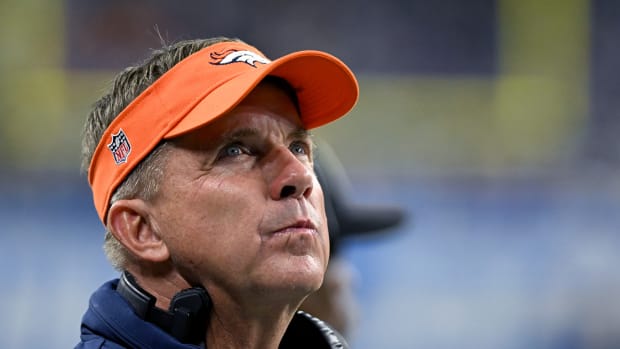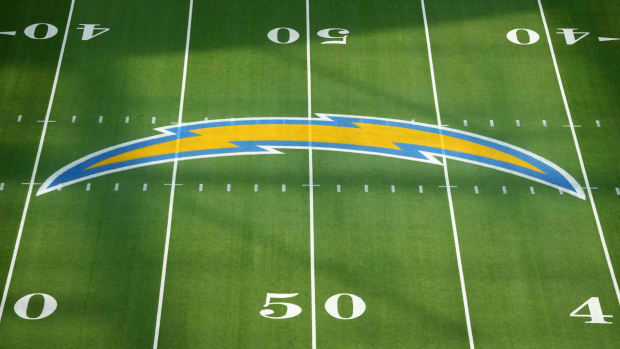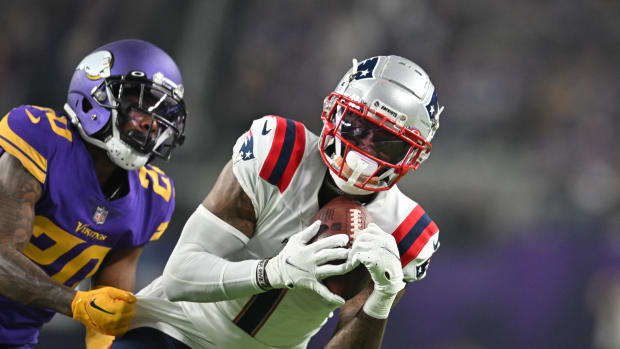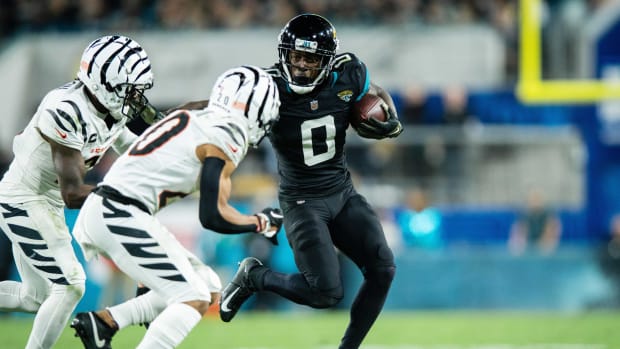SI 64, Nos. 59-55: AJ McCarron, Jarvis Landry, Jackson Jeffcoat and more
AJ McCarron is not going to blow anyone away with his arm strength or mobility. (David E. Klutho/SI)
With the draft just about a month away, it’s time for every NFL team to start getting their draft boards in order, and ranking players in order based on their own preferences. At SI, it’s time for us to do that, as well. And to that end, Doug Farrar and Chris Burke have assembled their own definitive Big Board, consisting of the players they feel deserve to be selected in the first two rounds.
The SI 64, which debuted with a look at prospect Nos. 64-60, uses tape study to define the best prospects in this class, and why they’re slotted as such. At the bottom of the hypothetical second round, we have a few small-school stars, and a couple of hidden gems with specific limitations who could be great in the right settings.
No. 59: Bashaud Breeland, CB, Clemson
Bio: Breeland was an unexpected addition to the 2014 draft class when he declared back in January, skipping his senior season. He may have been able to push into Round 1 with another year at Clemson, but he should have no problem landing a shot somewhere now. A groin injury that eventually required surgery slowed him down in 2012. He bounced back last year to pick off five passes and land a second-team All-ACC nod. Clemson's own website tabbed the 5-foot-11, 190-pound corner as "one of the team's most physical defensive backs". He pushed that description a little too far with a targeting penalty on Florida State QB Jameis Winston.
Strengths: Definitely passes the eye test at cornerback, carrying an athletic-looking 5-11 with nearly 32-inch arms. Breeland uses that lankiness and his leaping ability to find the football deep, attacking it at its highest point when he manages to get his head around. Very comfortable stepping up in press coverage, and flips his hips well when forcing receivers out to the boundary. Often shifted in Clemson's alignments, even dropping back to safety -- where he played in high school. If he spots an INT opportunity in front of him, he plants and drives toward the football with authority. Mixes it up in the run game when he gets the chance, as evidenced by a 10-tackle showing at Virginia.
MORE COVERAGE: SI64: Our complete list of the top 64 prospects in 2014 NFL draft
Weaknesses: Not quite as fluid when playing off-man coverage or dropping into zone. Instances of him getting beat deep were rare, but they happened because Breeland is short on an extra gear. As aggressively as he plays the football, he sometimes struggles to get his head turned when running with receivers deep, which can leave him blindly flailing or grabbing downfield. He needs a clear shot to be productive against the run; when blockers engage him directly, he can be pushed out of the play too easily. Not a great tackler, either -- one Florida State TD came because he whiffed as the last line of defense.
Conclusion: A team that already has a No. 1 cornerback in place ought to be thrilled to land Breeland, who could handle the No. 2 role or drop into the slot (ideally, the former). Down the road, the potential is there for Breeland to be a true No. 1 cornerback, if he can refine his technique and learn to make up for his speed deficiencies by being more of a pest near the line.
NFL player comparison: Keenan Lewis, New Orleans Saints (3rd round, 2009, Oregon State)
No. 58: AJ McCarron, QB, Alabama
Bio: Heisman runner-up. Two-time national champ. Ripped the love of Brent Musberger's life away from him. It feels like McCarron has been Alabama's starting quarterback since the Reagan administration, so his résumé is common knowledge by this point. He lost just four games as the Crimson Tide's starter (including that instant classic at Auburn to prevent an Alabama three-peat). McCarron's college career ended with the 2013 Maxwell Award as Player of the Year, thanks to 3,000 yards passing and 28 touchdowns.
Strengths: Even for a QB sheltered within his offensive system, a career TD:INT differential of 77-15 speaks to noteworthy decision-making. For the most part, McCarron rolls through his progressions well and shows a strong sense for when he can push the envelope a bit. Utilizes play-action well, with enough athleticism to move the pocket. Accurate and consistent across the board. Obviously, the experience leading Alabama put McCarron into high-pressure situations, which he handled with aplomb.
MORE: 2014 NFL Mock Draft Database | Top centers | Top guards | Top tackles
Weaknesses: Stretching the field vertically needs to be a small piece of any offense he runs, as opposed to a main component, because he does not have a cannon for an arm. The ball occasionally floats on him, though it appears to be a correctable mechanical problem. Will scouts fault McCarron for playing on a borderline dynasty? His pro offensive line will not afford him the type of omnipresent pocket that he enjoyed at Alabama.
Conclusion: Go ahead and slap the dreaded "game-manager" tag on McCarron if you must. It's true: He is not going to blow anyone away with his arm or his mobility. However, it is foolish to pretend that anyone could have accomplished what he did at Alabama. Mentally, he has what it takes to stick in the NFL and his leadership qualities will be high up his list of positives. Expecting McCarron to step in and start from day one as a rookie would be a mistake. He could, however, serve as a competent backup, capable of stepping up in a pinch. Given enough time in that role, he may earn a starting job.
NFL player comparison: Kirk Cousins, Washington Redskins (4th round, 2012, Michigan State)
No. 57: Jarvis Landry, WR, LSU
Bio: Landry's teammate, Odell Beckham Jr., has been feeling the love as a potential first-rounder. Landry outproduced him as a receiver this past season: 77 catches for 1,193 yards and 10 touchdowns to 57 for 1,117 and 8 for Beckham. And it was Landry who was voted the team's MVP for 2013. His combine came to an early end due to a calf injury, following a disappointing 4.77-second 40 time. Speed is not his game, though.
Strengths: Can play inside or out, though he is most well-suited for a slot position. It's all about the hands and the catch radius for Landry, who will fight for the football. There are plenty of examples displaying his ability to adjust on the football, and he stays in control of his body enough to make back-shoulder grabs. Plays faster than he is (and definitely faster than that combine 40), hence LSU's frequent use of him on bubble screens. Finds openings in the defense when plays break down, and rarely allows himself to be tackled on the first attempt. He will fight through physical coverage.
Weaknesses: Though effective as a catch-and-run weapon, he does not possess the jets to win on many vertical routes in the NFL. Scouts no doubt will wonder why he has to make so many difficult catches. In other words, is he failing to create separation from defenders? Landry does not give the impression that he minds blocking, but a lot of his work there is of the get-in-the-way variety as opposed to seeking out defenders. From time to time, you'll see a ho-hum route from him if he's not the No. 1 option on a play.
Conclusion: Because of how Landry plays the game, there are very few scenarios that play out with him flopping as an NFL receiver. Another five or 10 pounds on his frame and Landry might earn some more comparisons to Anquan Boldin -- a versatile player who thrives in tight coverage. As it is, Landry projects out as a chain-moving possession receiver with upside as a No. 2 option in the passing game.
NFL player comparison: Greg Jennings, Minnesota Vikings (2nd round, 2006, Western Michigan)
No. 56: Will Sutton, DT, Arizona State
Bio: Nowhere was the roller coaster that was Sutton's college career more accurately tracked than on the scale. Sutton played at 275 pounds during a breakout, 13-sack 2012 that earned him All-America honors; he ballooned up over the 300-pound mark for 2013, a change that coincided with a drop in production. Though he took home the Pac-12's Defensive Player of the Year for a second straight time, Sutton notched just four sacks last season and dropped from 23.5 tackles for loss to 13.5. Sutton has been trying to cut weight recently (he was 303 at the combine and 297 at his pro day), but he's been sluggish at best in workouts.
Strengths: More athletic than one might expect given his fluctuating size, and that much is especially evident when Sutton comes off his block to chase the ball. Solid recognition of the screen game -- another area where Sutton's surprising agility becomes a factor, as he is adept at dancing past cut blocks. He's at his best when he can time the snap because of an explosive first step. Experienced at several spots on the line, and working out of varying gaps. Landing in an NFL strength and conditioning program would do wonders for him; he was dominant at that 275-pound weight.
Weaknesses: Sutton's height (6-0) is one concern. His relatively short arms are another -- at 31 1/4-inches, Sutton had the least length in that category of any D-lineman at the combine. The combination of size issues might help explain why Sutton still has trouble overpowering offensive linemen once they get their hands into his chest. Conditioning also needs to improve, though sticking under 300 pounds would help. Sutton can take himself out of position when he rushes vertically, something NFL teams may take advantage of with change-of-direction runs.
Conclusion: While he may not be an every-down player from the jump, Sutton's ability to disrupt opposing backfields should lead to him come off the board by Round 2 at the latest. And that's even with the size/fitness concerns. His Arizona State days have given him enough background to play in either a 4-3 or 3-4, though he could be a nightmare for the opposition as a 4-3 three-tech tackle. Regardless of his actual positioning, Sutton will deliver plays. Can he be consistent with those efforts?
NFL player comparison: Henry Melton, Dallas Cowboys (4th round, 2009, Texas)
No. 55: Jackson Jeffcoat, DE, Texas
Bio: The lanky Jeffcoat (6-3, 247 pounds) was named the 2013 Big 12 Defensive Player of the Year and actually led Texas in tackles with 82. His NFL hopes more tie into his ability to get to the quarterback -- 13 sacks last season and 49.5 tackles for loss during his career. Can he continue to play defensive end in the pros? That's the main question right now, with Jeffcoat perhaps ticketed for a 3-4 OLB spot instead.
Strengths: Shoots his hands out well, preventing blockers from delivering the first blow. This can help him stretch out run plays to his side by stalemating his man on the edge. Very quick when he sees an opening, and uses that speed to close from the backside. Really effective when he stunted, taking advantage of his speed versus moving interior linemen. Played out of both two- and three-point stances at DE. Texas also dropped him off the line on occasion, essentially turning him into a linebacker behind a three-man front. From there, he found gaps blitzing while also showing some decent coverage footwork. Won't miss many tackles.
Weaknesses: The pass-rush repertoire is fairly simple -- if Jeffcoat doesn't beat his man off the snap with his first move, there usually is not a backup plan. Stays very upright, which can allow him to swat a pass here or there but makes it difficult at times for him to turn the corner against a tackle. Jeffcoat does not look as if he'll be much of a factor versus the run as a DE, as most tackles or tight ends should be able to move him. Carries that "tweener" label ... small for an NFL end, inexperienced as a possible OLB.
Conclusion: Jeffcoat's level of success will depend on how well (and how creatively) his new defensive coordinator can use him. Straight-up against tackles, he was a little hit or miss; when Texas stunted him, moved him to a two-point stance inside or dropped him back as a working LB, his athleticism allowed him to excel. Jeffcoat's proven track record of getting to the QB will sell him, in spite of his lean frame. More than anything, teams just want players who can rattle offenses.
NFL player comparison: Jerry Hughes, Buffalo Bills (1st round, 2010, TCU)




































